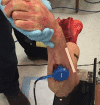Measurements of Tendon Movement Within the Bicipital Groove After Suprapectoral Intra-articular Biceps Tenodesis in a Cadaveric Model
- PMID: 33553457
- PMCID: PMC7829533
- DOI: 10.1177/2325967120977538
Measurements of Tendon Movement Within the Bicipital Groove After Suprapectoral Intra-articular Biceps Tenodesis in a Cadaveric Model
Abstract
Background: Lesions of the long head of the biceps can be successfully treated with biceps tenotomy or tenodesis when surgical management is elected. The advantage of a tenodesis is that it prevents the potential development of a cosmetic deformity or cramping muscle pain. Proponents of a subpectoral tenodesis believe that "groove pain" may remain a problem after suprapectoral tenodesis as a result of persistent motion of the tendon within the bicipital groove.
Purpose/hypothesis: To evaluate the motion of the biceps tendon within the bicipital groove before and after a suprapectoral intra-articular tenodesis. The hypothesis was that there would be minimal to no motion of the biceps tendon within the bicipital groove after tenodesis.
Study design: Controlled laboratory study.
Methods: Six fresh-frozen cadaveric arms were dissected to expose the long head of the biceps tendon as well as the bicipital groove. Inclinometers and fiducials (optical markers) were used to measure the motions of the scapula, forearm, and biceps tendon through a full range of shoulder and elbow motions. A suprapectoral biceps tenodesis was then performed, and the motions were repeated. The motion of the biceps tendon was quantified as a function of scapular or forearm motion in each plane, both before and after the tenodesis.
Results: There was minimal motion of the native biceps tendon during elbow flexion and extension but significant motion during all planes of scapular motion before tenodesis, with the most motion occurring during shoulder flexion-extension (20.73 ± 8.21 mm). The motion of the biceps tendon after tenodesis was significantly reduced during every plane of scapular motion compared with the native state (P < .01 in all planes of motion), with a maximum motion of only 1.57 mm.
Conclusion: There was a statistically significant reduction in motion of the biceps tendon in all planes of scapular motion after the intra-articular biceps tenodesis. The motion of the biceps tendon within the bicipital groove was essentially eliminated after the suprapectoral biceps tenodesis.
Clinical relevance: This arthroscopic suprapectoral tenodesis technique can significantly reduce motion of the biceps tendon within the groove in this cadaveric study, possibly reducing the likelihood of groove pain in the clinical setting.
Keywords: biceps tendon; shoulder; shoulder arthroscopy; tendinopathy; tendon biomechanics.
© The Author(s) 2021.
Conflict of interest statement
One or more of the authors has declared the following potential conflict of interest or source of funding: The anchors used for tenodesis in this study were donated by Arthrex. B.J.K. has received research support from Arthrex; educational support from Mid-Atlantic Surgical Systems and Smith & Nephew; and hospitality payments from Biomet and Exactech. S.A. has received research support, consulting fees, and speaking fees from Arthrex and educational support from Mid-Atlantic Surgical Systems. AOSSM checks author disclosures against the Open Payments Database (OPD). AOSSM has not conducted an independent investigation on the OPD and disclaims any liability or responsibility relating thereto.
Figures







Similar articles
-
Anatomic and radiographic comparison of arthroscopic suprapectoral and open subpectoral biceps tenodesis sites.Am J Sports Med. 2013 Dec;41(12):2919-24. doi: 10.1177/0363546513503812. Epub 2013 Sep 20. Am J Sports Med. 2013. PMID: 24057029
-
All-arthroscopic suprapectoral versus open subpectoral tenodesis of the long head of the biceps brachii.Am J Sports Med. 2015 May;43(5):1077-83. doi: 10.1177/0363546515570024. Epub 2015 Mar 29. Am J Sports Med. 2015. PMID: 25817189
-
Proximal Biceps Tenodesis: An Anatomic Study and Comparison of the Accuracy of Arthroscopic and Open Techniques Using Interference Screws.Orthop J Sports Med. 2014 Feb 19;2(2):2325967114522198. doi: 10.1177/2325967114522198. eCollection 2014 Feb. Orthop J Sports Med. 2014. PMID: 26535300 Free PMC article.
-
Suprapectoral versus subpectoral tenodesis for Long Head Biceps Brachii tendinopathy: A systematic review and meta-analysis.Orthop Traumatol Surg Res. 2020 Jun;106(4):693-700. doi: 10.1016/j.otsr.2020.01.004. Epub 2020 May 24. Orthop Traumatol Surg Res. 2020. PMID: 32461094
-
Surgical treatment for long head of the biceps tendinopathy: a network meta-analysis.J Shoulder Elbow Surg. 2020 Jun;29(6):1289-1295. doi: 10.1016/j.jse.2019.10.021. Epub 2020 Feb 6. J Shoulder Elbow Surg. 2020. PMID: 32037231
Cited by
-
Novel all-arthroscopic biceps tenodesis technique incorporated into rotator cuff repair-two hundred cases with minimum 2-year follow-up.JSES Int. 2023 Aug 2;8(3):459-463. doi: 10.1016/j.jseint.2023.07.008. eCollection 2024 May. JSES Int. 2023. PMID: 38707557 Free PMC article.
-
Arthroscopic Intra-articular Biceps Tenodesis With All-Suture Anchor.Video J Sports Med. 2025 Feb 27;5(1):26350254241301446. doi: 10.1177/26350254241301446. eCollection 2025 Jan-Feb. Video J Sports Med. 2025. PMID: 40308337 Free PMC article.
-
Single-Portal Proximal Biceps Tenodesis Using an All-Suture Anchor.Arthrosc Tech. 2022 Mar 16;11(4):e497-e503. doi: 10.1016/j.eats.2021.11.023. eCollection 2022 Apr. Arthrosc Tech. 2022. PMID: 35493056 Free PMC article.
References
-
- Berlemann U, Bayley I. Tenodesis of the long head of biceps brachii in the painful shoulder: improving results in the long term. J Shoulder Elbow Surg. 1995;4(6):429–435. - PubMed
-
- Boileau P, Baque F, Valerio L, Ahrens P, Chuinard C, Trojani C. Isolated arthroscopic biceps tenotomy or tenodesis improves symptoms in patients with massive irreparable rotator cuff tears. J Bone Joint Surg Am. 2007;89(4):747–757. - PubMed
-
- Boileau P, Krishnan SG, Coste JS, Walch G. Arthroscopic biceps tenodesis: a new technique using bioabsorbable interference screw fixation. Arthroscopy. 2002;18(9):1002–1012. - PubMed
-
- Duff SJ, Campbell PT. Patient acceptance of long head of biceps brachii tenotomy. J Shoulder Elbow Surg. 2012;21(1):61–65. - PubMed
LinkOut - more resources
Full Text Sources
Other Literature Sources

